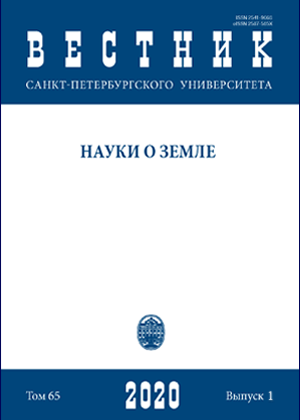Study of seismic wave fields in the reservoir zones by the numerical simulation
DOI:
https://doi.org/10.21638/spbu07.2020.103Abstract
This paper presents a study of seismic wave fields in reservoir zones by numerical simulation. In the first part of the study, numerical modeling of full wavefield was performed to synthesize the multi-offset vertical profiling data and data of OPV (Common Source Point Technique) for the model of the medium in which high-velocity layers (seal and collector) are placed in a low-velocity containing medium. It has been established that the principal boundary, the roof of the collector, can be distinguished by data only in the case of great thickness of high-velocity seal from the field of converted P1S2S2P1 and P1S2S21 waves. These waves are formed on the roof of the seal during the passage of a converted transverse wave and exist only in a certain interval of epicentral distances from the source, the length of which depends on the contrast of the
high-velocity seal, as well as on its thickness and depth. Reliable determination of the boundary between the high-velocity seal and the collector can be difficult when using only ground-based seismic data due to the screening effect. However, it becomes possible with the use of multi-offset vertical profiling materials and the correct use of the data of reflected converted P1S2S2P1 and P1S2S21 waves. In the second part of the work, we analyze the results of numerical model studies of the full-wave seismic response from a thin-layered pack of saturated elastic porous Biot layers simulating a reservoir zone. The results of numerical model studies show that the low-frequency amplitude anomalies observed in seismic sections below the reservoir zone may be caused by the formation of a field of reflected converted transverse waves that are delayed relative to the response of the longitudinal wave and having significant amplitudes on the vertical field component for the small and middle offsets. The amplitudes and time delays of the total converted transverse wave can vary widely depending on specific conditions: depth and reservoir thickness, incident longitudinal wave frequency, the presence of boundaries in the reservoir area with sliding contact or extended thin cracks filled with fluid, and other factors.
Keywords:
numerical modeling, seismic wave fields, collector, screening effect, Biot layers
Downloads
References
Downloads
Published
How to Cite
Issue
Section
License
Articles of "Vestnik of Saint Petersburg University. Earth Sciences" are open access distributed under the terms of the License Agreement with Saint Petersburg State University, which permits to the authors unrestricted distribution and self-archiving free of charge.






